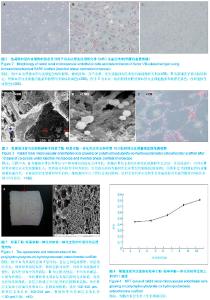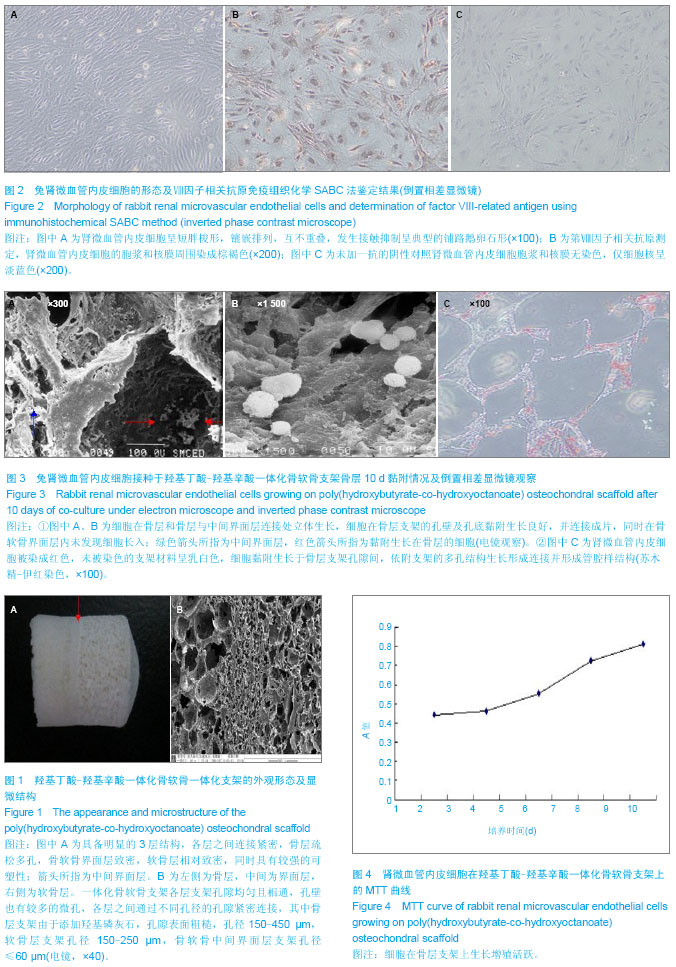| [1] Gao J,Dennis JE,Solchaga LA,et al.Repair of osteochondral defect with tissue-engineered two-phase composite material of injectable calcium phosphate and hyaluronan sponge. Tissue Eng.2002;8(5):827-837.[2] Jiang J,Tang A,Ateshian GA,et al.Bioactive stratified polymer ceramic-hydrogel scaffold for integrative osteochondral repair.Ann Biomed Eng.2010;38(6):2183-2196.[3] Harley BA,Lynn AK,Wissner-Gross Z,et al.Design of a multiphase osteochondral scaffold III: Fabrication of layered scaffolds with continuous interfaces. J Biomed Mater Res A.2009;3:1078-1093.[4] Havla JB,Lotz AS,Richter E,et al.Cartilage tissue engineering for auricular reconstruction: in vitro evaluation of potential genotoxic and cytotoxic effects of scaffold materials. Toxicology In Vitro. 2010;24(3):849-853.[5] Galois L,Freyria AM,Grossin L,et al.Cartilage repair: surgical techniques and tissue engineering using polysaccharide- and collagen-based biomaterials. Biorheology. 2004;41:433-443.[6] 张婵,董岳峰,王海宾,等.费氏中华根瘤菌合成羟基丁酸和羟基己酸共聚体的研究[J].微生物学通报,2007,34(6):1077- 1081.[7] 陈璋,张蝉,郭羽,等.羟基丁酸与羟基辛酸共聚物载阿霉素缓释纳米微球的研究[J].山西大学学报,2009,32(2):258-262.[8] Zhang C,Zhao LQ,Dong YF.Folate-mediated poly(3- hydroxybutyrate-co-3-hydroxyoctanoate) nanoparticles for targeting drug delivery.Eur J Pharm Biopharm.2010;76:10-16.[9] Freed LE,Marquis JC,Nohria A,et al.Neocartilage formation in vitro and in vivo using cells cultured on synthetic biodegradable polymers.J Biomed Mater Res.1993; 27(1): 11-23.[10] 李二峰,王增荣,陆兴,等.羟基丁酸-羟基辛酸聚合物-胶原骨软骨支架的制备及应用[J].中国组织工程研究,2012,16(47): 8751- 8754.[11] Hsu YY,Gresser JD,Trantolo DJ,et al.Effect of polymerfoam morphology and density on kinetics of in vitro controlled release of isoniazid from compressed foam matrices.J Biomed Mater Res.1997;35(1):107-116.[12] Green DF,Hwang KH,Ryan US.Culture of endothelial cells from baboon and hurnan glomeruli.Kidney Ini.1992;41(6): 1506-1516.[13] 张亚,王晓东,王明海,等.兔血管内皮细胞和诱导成骨细胞在可注射纳米材料上的共培养[J].中国组织工程研究与临床康复,2007, 11(31):6125-6129.[14] Jain RK,Au P,Tam J,Duda DG,et al.Engineering vascularized tissue.Nat Biotechnol.2005;23:821-823.[15] Karageorgiou V,Kaplan D.Porosity of 3D biomaterial scaffolds and osteogenesis. Biomaterials. 2005;26:5474-5491.[16] Ekaputra AK,Prestwich GD,Cool SM,et al.The three-dimensional vascularization of growth factor-releasing hybrid scaffold of poly (varepsilon-caprolactone)/collagen fibers and hyaluronic acid hydrogel. Biomaterials.2011;32: 8108-8117.[17] Soliman S,Sant S,Nichol JW,et al.Controlling the porosity of fibrous scaffolds by modulating the fiber diameter and packing density.J Biomed Mater Res A.2011;96:566-574.[18] Navarro M,Michiardi A,Castano OJ,et al.Biomaterials in orthopaedics.J R Soc Interface. 2008;5:1137-1158.[19] 张永红,许钰,林汲,等.羟基丁酸-羟基辛酸共聚体/脱细胞软骨基质支架的细胞黏附性[J].中国组织工程研究与临床康复,2010, 14(25):4585-4588.[20] 林汲,谢红,张婵,等.聚羟基丁酸与羟基辛酸骨组织工程支架的表面修饰[J].中国组织工程研究与临床康复,2009,13(42): 8245- 8247.[21] Engler AJ,Sen S,Sweeney HL,et al.Matrix elasticity directs stem cell lineage specification. Cell.2006;126:677-689.[22] Pizzo AM,Kokini K,Vaughn LC,et al.Extracellular matrix (ECM) microstructural composition regulates local cell-ECM biomechanics and fundamental fibroblast behavior: A multidimensional perspective.J Appl Physiol. 2005;98:1909- 1921.[23] Badylak SF.The extracellular matrix as a biologic scaffold material. Biomaterials.2007;28:3587-3593.[24] Nelson CM,Tien J.Microstructured extracellular matrices in tissue engineering and development.Curr Opin Biotechnol. 2006;17:518-523.[25] Zhang R,Ma PX.Poly(alpha-hydroxyl acids)/hydroxyapatite porous composites for bone-tissue engineering. I. Preparation and morphology.J Biomed Mater Res. 1999;44:446-455.[26] Zeltinger J,Sherwood JK,Graham DA,et al.Effect of pore size and void fraction on cellular adhesion, proliferation, and matrix deposition.Tissue Eng. 2001;7:557-572.[27] Harley BA,Kim HD,Zaman MH,et al.Microarchitecture of three-dimensional scaffolds influences cell migration behavior via junction interactions.Biophys J.2008;95:4013-4024.[28] Nehrer S,Breinan HA,Ramappa A,et al.Matrix collagen type and pore size influence behavior of seeded canine chondrocytes.Biomaterials .1997;18:769-776.[29] Wake MC,Patrick CW Jr,Mikos AG.Pore morphology effects on the fibrovascular tissue growth in porous polymer substrates. Cell Transplant.1994;3:339-343.[30] Yannas IV.Tissue and Organ Regeneration in Adults. New York: Springer; 2001.[31] Yannas IV,Lee E,Orgill DP,et al.Synthesis and characterization of a model extracellular matrix that induces partial regeneration of adult mammalian skin. Proc Natl Acad Sci USA.1989;86:933-937.[32] Harley BA,Spilker MH,Wu JW,et al.Optimal degradation rate for collagen chambers used for regeneration of peripheral nerves over long gaps. Cells Tissues Organs.2004;176: 153-165.[33] Hulbert SF,Young FA,Mathews RS,et al.Potential of ceramic materials as permanently implantable skeletal prostheses.J Biomed Mater Res.1970;4:433-456.[34] 沈士亮,徐玉会,武忠弼.葡萄球菌A蛋白胶体金银法对血管内皮细胞第Ⅷ因子相关抗原的研究[J].中华病理学杂志,1989,18(1): 69-70.[35] Martin GM,Ogburn CE.Cell Tissue and Organic culture of blood vessels.in:RolbblatGH,Firstofals VG,eds.Growth, Nutrition,and Metabolism of cell in culture. 1 st ed.New York, Academic Publishers.1977. |

